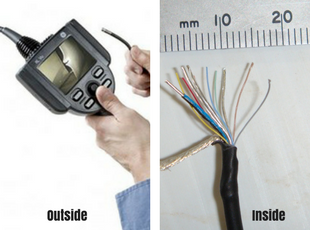What’s Inside a Borescope Probe?

Modern video borescopes are pretty amazing inspection tools, with probes up to 30m long, down to 2.3mm diameter, capable of multidirectional articulation, sub-millimetre measurement accuracy and even 3D point cloud generation! But have you ever stopped to think about the technology that makes this all possible?
Well, it all comes down to the probe. So what are the components inside a borescope probe and how do they work together to make your inspections possible? Let’s start with an overall view of a probe, so we can lay out the basic segments before delving inside the probe cable.
 Figure 1: the key sections of a borescope probe.
Figure 1: the key sections of a borescope probe.
Starting at the handset and working towards the tip of the probe, we have the torsional strain relief; this protects the probe from stress (especially twisting) where it enters the handset. Next is the insertion tube, which makes up the majority of the probe’s length (2m up to 30m). Then comes the all-important flexible bending neck, this is where the articulation happens. Finally, at the very tip of the probe is the camera head, this can also accept optical tips or measurement tips, depending on your inspection needs.
From the handset, all the way up to the camera head, the probe contains an incredible number of miniaturised components. If you took a cross-section of the probe, these are the components you would find:
Figure 2: a close-up view of some of the electrical conductors buried within a borescope probe.
- More than a dozen electrical conductors (wires), including power, video signals, temperature sensors, LED lighting power for 3D phase measurement, plus other proprietary signals (see figure 2). Beneath its protective insulation, each conductor is only 0.1mm in diameter, which is about the same as a human hair!
- Fibre optic light guide – a bundle of flexible optical glass fibres to transmit high-intensity lighting from a LED inside the handset, all the way to the tip of the probe.
- Articulation cables – four braided steel wires to control up/down and left/right movement of the bending neck. To fit within the tight space constraints of the probe, each articulation cables is as thin as 0.2mm in diameter, with a 0.6mm diameter protective spring-steel conduit surrounding it!
- Surrounding all of the above are multiple protective layers, including:
- insulation and sheathing on the electrical conductors and fibre optics
- coiled spring steel conduit on the articulation cables
- steel mono coil conduit surrounding the whole probe
- two layers of rugged polyurethane rubber
- braided tungsten wire sheathing
- Additionally, under its braided tungsten sheath, the flexible bending neck is protected from crushing by segmented “vertebrae”, made from a high-strength proprietary alloy.
Figure 3 provides a detailed view of how these various components come together to make-up a probe.
Hopefully, this article has provided a bit of insight into the fascinating miniaturised design and details that go into producing a high-quality borescope probe. In next month’s newsletter, we’ll have a look at some tips and tricks for maximising articulation, looking after your probes and getting the most out of any borescope system.
Find out more about our borescope systems or contact us today for a no-obligation chat.


